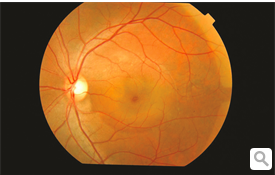What is Central Serous Chorioretinopathy?
This condition, often referred to as CSC, is caused by an accumulation of fluid under the retina which causes a serous (fluid-filled) detachment and vision loss. The vision loss usually lasts a few weeks to months without treatment, but can occasionally become chronic or recur. CSC most often occurs in young and middle-aged adults, and for unknown reasons, more commonly effects men.
What are the symptoms?
CSC usually presents as blurry and/or distorted central vision affecting one eye but upon careful examination, there is sometimes involvement in the other eye as well. Depending on the amount and location of the serous fluid under the retina, you may not have any symptoms at all! If the fluid accumulates within the macula, you are more likely to experience symptoms.

What are the causes and risk factors?
There are no proven causes of CSC and the condition is not fully understood. It is thought that any systemic exposure to corticosteroids, including but not limited to allergy nose sprays and anti-inflammatory skin creams, may induce or worsen symptoms. Studies have also shown a correlation between CSC and patients with emotional distress and/or “type A” personalities which may be caused by the bodies release of natural corticosteroids in times of stress.
As for the risk factors, approximately half of patients diagnosed with CSC have at least one relative with similar findings which could mean the condition partially has to do with genetics. Patients with high blood pressure or heart disease, and those with a current or recent pregnancy have also been shown to be at higher risk of developing CSC. Several other drugs including stimulants, decongestants, erectile dysfunction medications, and some anti-cancer agents may also increase the risk of developing CSC.
How is CSC diagnosed?
The first step is a dilated eye exam, followed by imaging of the retina. Optical coherence tomography (OCT) is a scan of the retina that helps to identify fluid or scarring as a result of fluid in acute or chronic CSC. Fluorescein angiography (FA) is another test in which a dye injected into a patient’s arm is used to visualize leakage beneath the retina. Both OCT and FA help Dr. Notaro to make the diagnosis of CSC and distinguish it from other retinal diseases that cause fluid in the macula.
What are the treatment options?
As previously mentioned, CSC can often resolve on its own but in chronic CSC cases, thermal laser treatments, oral medications, and eye injections may be necessary. In acute cases, discontinuing corticosteriod use may be considered but always check with your prescribing physician before doing so.
In order to avoid permanent vision loss, early detection and treatment of CSC is most beneficial. Depending on the severity of your symptoms and how long you’ve had them, Dr. Notaro will choose the best treatment option for you which often begins with a trial of observation.
DON’T WAIT! Call (716) 839-9009 to schedule an appointment with Saralyn Notaro Rietz, your Back of the Eye MD! She has over 20 years experience diagnosing and treating diseases of the retina.
References
https://www.asrs.org/patients/retinal-diseases/21/central-serous-chorioretinopathy






